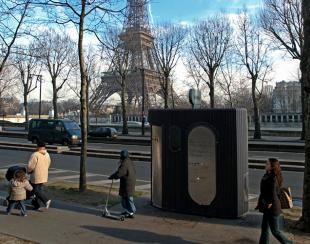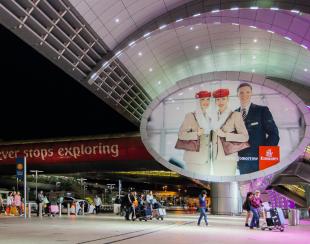1964-72
The beginnings
1964
Jean-Claude Decaux invents the new concept and business model of 'street furniture', with bus shelters financed by advertising. JCDecaux is born, and also a brand new 2 m2 advertising format.
Lyon (France) becomes the first city to adopt JCDecaux's business model.

1971
The installation of street furniture in Lisbon, Portugal sees the launch of the company’s first non-French-speaking subsidiary.

1966
Two years after the company launched, JCDecaux extends its activities into Belgium, creating the Group's first subsidiary.

1967
Our global headquarters are established in Plaisir, near Paris. 50 years on, more than 700 employees from across 100 business areas are based there.
1972-1982
Brand and city innovation
1972
The free-standing Council Information Panel (CIP) is developed. With advertising on one side and council information, including wayfinding, on the other, the CIP changes the game of how concession agreements are awarded. Today, well-designed non-advertising products are now included as part of contracts.

1976
The scrolling 6-sheet panel marks the first product designed to embody the ‘less is more’ advertising ethos.

1980
Designed for cleanliness, ease of use, reliability and focused on saving energy and water, automatic public toilets (APCs) are first installed in Paris in 1980.
1982-1999
Design and business development
1982
The first street furniture is installed in Germany in 1982, in Hamburg. In 1990, a few months before reunification, JCDecaux becomes one of the first companies to invest in Eastern Germany, with a contract with the city of Leipzig.

1992
Lord Norman Foster becomes the first designer to collaborate with JCDecaux to design street furniture products. Since then, we have worked with over 50 designers globally, including Mario Bellini, Philippe Starck, Jean-Michel Wilmotte , Marc Aurel and Zaha Hadid.

1998
Installed by Infoscreen, the Group's first digital displays go live in the Vienna Metro.

1984
JCDecaux enters the UK market with a bus shelter contract in The Royal Borough of Kingston Upon Thames. This marks the introduction of 6-sheets in the UK. Our business ethos - to enhance public spaces along with advertising supply - wins the hearts of city architects and leads to an overall improvement in Out-of-Home products UK-wide.

1994
JCDecaux wins its first American contract - accessible public toilets in San Francisco.

1997
The City of Sydney contract marks the Group's first entry into Oceania. The contract is awarded thanks to JCDecaux's close collaboration with the designer Philip Cox and the quality of our street furniture maintenance.
1999-2013
The challenger brand becomes number 1 worldwide
1999
JCDecaux acquires Avenir, the Out-of-Home media communication division of Havas Out-of-Home Media - Mills & Allen in the UK. Our product range now includes billboards and transport advertising.
2001
The company is floated on the Euronext Paris exchange.

2003
The ground-breaking self-service public bicycle hire scheme, Cyclocity, launches in Vienna. Public bicycles, funded by advertising revenue, are now available across 700 cities in over 50 countries.

2008
JCDecaux signs its first contract with Dubai International Airport in 2008. Other deals in the region would follow; by 2014 JCDecaux Middle East has grown to a 250-strong team.

2008
JCDecaux UK works in partnership with BAA to plan and develop advertising opportunities within the infrastructure of Heathrow Terminal 5 during its construction. It is widely considered the blueprint for the airport media development of the future.

2012
M-Vision is the first large format digital advertising product to be installed in UK shopping malls.

1999
JCDecaux wins the first advertising concession in Singapore, a city which previously refused advertising in public spaces, and installs advertising bus shelters on Orchard Road, the heart of the city's retail and entertainment hub.

2000
Scrolling backlights, considered a revolution in Out-of-Home by UK media agencies, and another example of JCDecaux's less is more product installation ethos, launch in the UK.

2001
JCDecaux Innovate launches in the UK, the division dedicated to devising eye-catching newsworthy campaigns. The concept rapidly rolls out across JCDecaux subsidiaries worldwide.

2008
The M4 Torch, the first iconic digital Out-of-Home product in the UK, and the first site of the Première Platinum collection, is unveiled.

2010
The purchase of Titan Outdoor propels JCDecaux UK into pole position in the rail advertising market.

2013
In 2013, JCDecaux invests further in South America, buying 85% of Eumex, a Mexican company founded in 1995. As a result, over 500 people join JCDecaux and its position is strengthened in Chile and Argentina as well as entering seven new countries.
2013-present
Interactivity and connectivity
2013
Consolidating its position as airport advertising market leader, JCDecaux UK launches sales opportunities for the brand new Heathrow Terminal 2 ahead of its opening in June 2014, having been closely involved in the advertising placement strategy during construction.

2014
The Motion @ Portfolio launches with the installation of Europe's largest digital screen at London Waterloo, the UK's busiest rail station.

2014
Channel Tesco is unveiled, the first data-fuelled, audience-traded digital Out-of-Home network. Creative copy can be changed by sales information, audience, weather and other environmental factors to optimise effectiveness.

2015
JCDecaux UK starts offering dynamic solutions, focused on making it easy for brands to create dynamic, contextual ads that use up-to-the-minute information to make them as relevant, eye-catching and effective as possible.

2016
JCDecaux UK announces a significant step in its digitisation of LDN - the complete synchronisation of London's Oxford Street.

2018
Launch of VIOOH (previously known as SmartBRICS), an independent and automated global planning and trading platform designed to connect media buyers and agencies to the digital programmatic ecosystem. Through the use of algorithms, VIOOH allows them to more easily access intelligent solutions that can be automatically adapted to the target audiences.

2018
JCDecaux UK unveils The Kensington, a unique, sculptural digital canvas designed by Zaha Hadid Design. The Kensington provides brands with a unique communications’ channel in the capital that combines the latest in digital screen technology with a spectacular, curved double-ribbon stainless steel design.

2018
JCDecaux UK wins the contract for the in-centre advertising at Westfield London and Westfield Stratford City, the premium retail, shopping and leisure destinations in London – ranked number one and two for mall retail spend in the UK.

2019
JCDecaux UK launches LDN Drive, a large format channel transforming the opportunities for advertisers to drive brand fame in the capital. Following the success of LDN Drive, National Drive launches later in the year, taking the large format digital proposition nationwide.

2019
JCDecaux becomes the first Out-of-Home Media company to join the RE100 initiative, reaffirming its commitment to the climate and renewable energies. As a member, JCDecaux is committed to 100% renewable power, with a pledge to achieve this globally by 2022. In the UK we achieved this pledge in 2019.

2020
P² + C = 5 by Justin Gibbons is released, the new formula for how marketers can harness the power of the public screen alongside the private screen to drive success through the brand funnel.

2013
JCDecaux UK enters the experiential advertising market. Campaigns to date include Jurassic World, Mamma Mia and Ghostbusters.

2014
JCDecaux UK wins the 10-year Out-of-Home advertising partnership with the City of Edinburgh. The contract includes UK city centre digital screens, interactive Live Touch screens providing local information; charging stations; and large format products, including the city's first large format digital.

2014
JCDecaux's urban networks become an integral part of urban connectivity as the Group partners with Vodafone, Huawei and Alcatel-Lucent for small cell deployment. Amsterdam becomes the first city to take advantage of the development, equipping over 400 bus shelters with the technology.

2015
SmartBRICs is launched, the ground-breaking media planning and buying platform, which allows campaigns to be planned, optimised and bought as efficiently and effectively as possible through the use of detailed third-party datasets.

2015
JCDecaux UK is awarded Transport for London (TfL)'s London bus shelter advertising concession, the largest of its kind in the world. Work begins immediately to digitally transform the city, installing a fully synchronised digital advertising product in London's retail, financial and tourist heartlands.

2015
The environmental revolution picks up pace as JCDecaux begins to install ever smarter, greener bus shelters. In Paris, new shelters equipped with photovoltaic panels, green roofs, USB chargers and digital information screens providing real-time and localised information are installed.

2017
JCDecaux UK and TfL celebrate the 500th digital screen installation in the world’s largest advertising bus shelter contract. The digital transformation of TfL’s bus shelter network is a core element of our vision to make London the global showcase for digital Out-of-Home.

2018
JCDecaux UK is awarded a five-year contract with Network Rail that will see us deliver an improved station experience with a 100% digital environment at Network Rail's stations.

2018
The takeover of APN Outdoor in Australia is the largest transaction since JCDecaux’s initial public offering in 2001. The acquisition paves the way for a significant expansion of the Group’s business in Australia, the world’s seventh largest advertising market, and one that is particularly receptive to digital Out-of-Home advertising. It also allows JCDecaux to gain a foothold in New Zealand.

2019
JCDecaux UK signs the London Borough of Camden bus shelter contract and now holds exclusive bus shelter contracts for all central London boroughs. The Camden award brings the number of digital bus shelter screens JCDecaux UK operates to 900, making London the largest digital advertising bus shelter network in the world.
